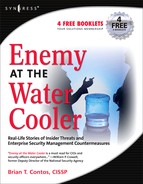0%
29Chapters
0-1Hours read
0kTotal Words
Book Description
The book covers a decade of work with some of the largest commercial and government agencies around the world in addressing cyber security related to malicious insiders (trusted employees, contractors, and partners). It explores organized crime, terrorist threats, and hackers. It addresses the steps organizations must take to address insider threats at a people, process, and technology level.Today’s headlines are littered with news of identity thieves, organized cyber criminals, corporate espionage, nation-state threats, and terrorists. They represent the next wave of security threats but still possess nowhere near the devastating potential of the most insidious threat: the insider. This is not the bored 16-year-old hacker. We are talking about insiders like you and me, trusted employees with access to information - consultants, contractors, partners, visitors, vendors, and cleaning crews. Anyone in an organization’s building or networks that possesses some level of trust.
* Full coverage of this hot topic for virtually every global 5000 organization, government agency, and individual interested in security.
* Brian Contos is the Chief Security Officer for one of the most well known, profitable and respected security software companies in the U.S.—ArcSight.
Book Description
The book covers a decade of work with some of the largest commercial and government agencies around the world in addressing cyber security related to malicious insiders (trusted employees, contractors, and partners). It explores organized crime, terrorist threats, and hackers. It addresses the steps organizations must take to address insider threats at a people, process, and technology level.Today’s headlines are littered with news of identity thieves, organized cyber criminals, corporate espionage, nation-state threats, and terrorists. They represent the next wave of security threats but still possess nowhere near the devastating potential of the most insidious threat: the insider. This is not the bored 16-year-old hacker. We are talking about insiders like you and me, trusted employees with access to information - consultants, contractors, partners, visitors, vendors, and cleaning crews. Anyone in an organization’s building or networks that possesses some level of trust.
* Full coverage of this hot topic for virtually every global 5000 organization, government agency, and individual interested in security.
* Brian Contos is the Chief Security Officer for one of the most well known, profitable and respected security software companies in the U.S.—ArcSight.
Table of Contents
- Copyright
- Praise for Enemy at the Water Cooler
- Acknowledgments
- About the Author
- Acknowledgements
- Technical Reviewer
- Foreword
- Introduction
- I. Background on Cyber Crime, Insider Threats, and ESM
- 1. Cyber Crime and Cyber Criminals 101
- About this Chapter
- Computer Dependence and Internet Growth
- Motivations for Cyber Criminal Activity
- Black Markets
- Hackers
- Script Kiddies
- Solitary Cyber Criminals and Exploit Writers for Hire
- Organized Crime
- Identity Thieves (Impersonation Fraudsters)
- Competitors
- Activist Groups, Nation-State Threats, and Terrorists
- Insiders
- Tools of the Trade
- Application-Layer Exploits
- Botnets
- Buffer Overflows
- Code Packing
- Denial-of-Service (DoS) Attacks
- More Aggressive and Sophisticated Malware
- Nonwired Attacks and Mobile Devices
- Password Cracking
- Phishing
- Reconnaissance and Googledorks
- Rootkits and Keyloggers
- Social Engineering Attacks
- Voice-Over IP (VoIP) Attacks
- Zero-Day Exploits
- Summary
- 2. Insider Threats
- 3. Enterprise Security Management (ESM)
- ESM in a Nutshell
- Key ESM Feature Requirements
- Event Collection
- Normalization
- Categorization
- Asset Information
- Vulnerability Information
- Zoning and Global Positioning System Data
- Active Lists
- Actors
- Data Content
- Correlation
- Prioritization
- Event and Response Time Reduction
- Anomaly Detection
- Pattern Discovery
- Alerting
- Case Management
- Real-Time Analysis and Forensic Investigation
- Visualization
- Detailed Visualization
- Reporting
- Remediation
- Return On Investment (ROI) and Return On Security Investment (ROSI)
- Alternatives to ESM
- Summary
- 1. Cyber Crime and Cyber Criminals 101
- II. Real Life Case Studies
- 4. Imbalanced Security—A Singaporean Data Center
- 5. Comparing Physical & Logical Security Events—A U.S. Government Agency
- 6. Insider with a Conscience—An Austrian Retailer
- 7. Collaborative Threat—A Telecommunications Company in the U.S.
- 8. Outbreak from Within—A Financial Organization in the U.K.
- 9. Mixing Revenge and Passwords—A Utility Company in Brazil
- 10. Rapid Remediation—A University in the United States
- 11. Suspicious Activity—A Consulting Company in Spain
- 12. Insiders Abridged
- III. The Extensibility of ESM
- 13. Establishing Chain-of-Custody Best Practices with ESM
- 14. Addressing Both Insider Threats and Sarbanes-Oxley with ESM
- 15. Incident Management with ESM
- 16. Insider Threat Questions and Answers
- Introduction
- Insider Threat Recap
- Question One—Employees
- Question Two—Prevention
- Question Three—Asset Inventories
- Question Four—Log Collection
- Question Five—Log Analysis
- Question Six—Specialized Insider Content
- Question Seven—Physical and Logical Security Convergence
- Question Eight—IT Governance
- Question Nine—Incident Response
- Question Ten—Must Haves
- A. Examples of Cyber Crime Prosecutions
- U.S. Department of Justice Cases
- California—Central District—United States v. Jay R. Echouafni et al. (Operation Cyberslam)
- United States v. Jie Dong
- United States v. Calin Mateias
- California—Northern District—United States v. Robert McKimmey
- United States v. Laurent Chavet
- United States v. Shan Yan Ming
- United States v. Robert Lyttle
- United States v. Roman Vega
- United States v. Michael A. Bradley
- Missouri—Western District—United States v. Melissa Davidson
- United States v. Soji Olowokandi
- New York—Southern District—United States v. Jason Smathers and Sean Dunaway
- Pennsylvania Western District—United States v. Calin Mateias
- United States v. Scott Eric Catalano
- United States v. Myron Tereshchuk
- United States v. Jeffrey Lee Parson
- U.S. Department of Justice Cases
- Bibliography
